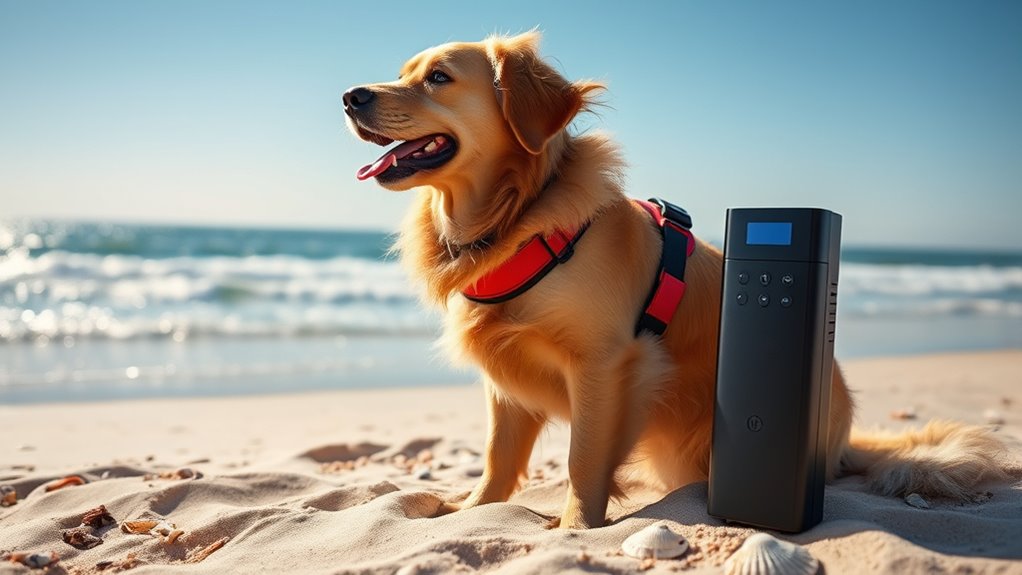To guarantee your pet’s safety during travel, microchipping is essential, as it greatly boosts the chances of being reunited if they get lost. Keep your microchip information up-to-date and carry recent photos and vet records. Preparing your pet with familiar belongings and proper crate training reduces stress. Planning ahead ensures safe adventures and peace of mind. Keep going to discover more tips for combining microchips and travel tricks for a smooth journey.
Key Takeaways
- Microchipping pets significantly increases the chances of recovery if they get lost during travel.
- Ensure your pet’s microchip information is up-to-date and registered with current contact details.
- Microchips help verify pet identity and ownership during border crossings or emergencies.
- Acclimate pets to travel crates and familiar items to reduce stress and promote safe adventures.
- Proper travel preparations, including vet check-ups and documentation, ensure safe and enjoyable travel experiences.

Are you ready to explore the world with your furry friend? Traveling with pets has become more popular than ever, with 78% of American pet owners hitting the road or skies with their animals each year. Whether it’s a weekend getaway or an extended holiday, planning ahead is key to guaranteeing a safe and enjoyable trip. One of the first steps is making sure your pet is properly prepared—this includes routine pet grooming to keep their coat clean and healthy, and scheduling vet visits to confirm they’re fit for travel. A quick check-up can reveal any health issues that might worsen during a trip, and updating vaccinations or microchip records assures your pet stays protected no matter where you go. Microchipping significantly increases the chances of recovering lost pets, making it a vital safety measure for traveling animals. Traveling with pets requires some extra planning, especially when it comes to accommodations. Fortunately, about 75% of hotels across the US now welcome pets, making it easier to find a place that feels like home away from home. Many chains like Best Western, Motel 6, and DoubleTree by Hilton have clear pet policies—just remember to confirm these directly before booking. Luxury hotels are raising the bar with amenities like super-luxe dog beds, gourmet pet hampers, and even on-site agility courses, turning travel into a pampering experience for your pet. More accommodations are eliminating extra pet fees and offering multi-dog rooms, making it more feasible to travel with a pack. When it comes to transportation, nearly 64% of pet travelers prefer to go by car, which offers flexibility and less stress for your pet. If you’re flying, be aware that 2 million pets board commercial flights in the US each year, but airline policies vary widely. Your pet might experience some stress during air travel, so proper crate acclimation and a vet check before departure can make a big difference. Other options like ferries and trains are available in regions like Europe, providing additional pet-friendly travel choices. Destination choices matter, too. Many pet owners prefer locations with hiking trails, parks, and beaches that welcome dogs. National parks and historic sites are popular, although access can be limited. Pet-friendly cities with walkable neighborhoods, cafes, and green spaces are also highly sought after, especially in the UK’s South East, South West, and East of England. Globally, destinations like France, Italy, and the UK offer plenty of pet-friendly beaches, parks, and accommodations. To ensure a smooth trip, it’s helpful to understand the pet travel regulations and requirements for your destination, which can vary widely. The key to a successful trip is preparation: making sure your pet’s paperwork is up to date, acclimating them to travel crates, and packing familiar items like toys or blankets. With these steps, you and your pet can enjoy safe adventures and create lasting memories wherever your travels take you.
Frequently Asked Questions
How Do Microchips Work Across Different Countries?
Microchips work across different countries thanks to international standards like ISO 11784 and ISO 11785, ensuring microchip portability worldwide. When you travel, your pet’s ISO-compatible microchip can be read with universal scanners used internationally. This compatibility helps verify your pet’s identity seamlessly, no matter where you go. Just make sure the microchip complies with the destination country’s requirements and that you keep documentation up-to-date for smooth entry.
What Should I Do if My Pet’s Microchip Is Not Registered?
If your pet’s microchip isn’t registered, you should register it immediately to guarantee proper pet identification. Update the registration with accurate contact details like your name, phone number, and address. Verify the microchip’s registration status using online tools or by consulting local shelters and vets. Regularly check and update the registration info, especially after moves. Proper microchip registration greatly improves your pet’s chances of being safely reunited if they get lost.
Are There Specific Microchip Brands Recommended for Travel?
Think of microchip brands like HomeAgain, Datamars, Avid, AKC Reunite, and BuddyID as your pet’s travel passport, ensuring compatibility across borders. You should choose brands with ISO-compliant microchips, which are essential for international travel. These brands also focus on microchip implantation procedures that are quick and comfortable. Selecting the right microchip guarantees your pet’s safe journey, with seamless scanning and reliable registration to keep your furry friend protected everywhere you go.
How Can I Ensure My Pet’s Microchip Information Is Always up to Date?
To keep your pet’s microchip info current, regularly verify it at least once a year, especially before travel. Use online tools or scan at your vet to check details and update your pet travel documentation. Set microchip renewal reminders to avoid lapses. Always confirm your contact info is accurate, and promptly notify the registry of any address or phone number changes. Staying proactive increases chances of a quick reunion if your pet gets lost.
What Are Alternative Identification Methods Besides Microchips?
Think of your pet’s ID as a safety net woven with various threads. Beyond microchips, you can use collar tags that display your contact info or engraved collars for permanence. DNA identification offers a unique, unchangeable signature for your pet, like a fingerprint. Combining visible collar tags with DNA ID creates a layered safety system, ensuring your furry friend’s safe return, even if one method is missed or lost.
Conclusion
With microchips and careful planning, your pet’s travel journey becomes a smooth sail through uncharted waters. Think of your adventure as a storybook where every page is filled with safe, joyful moments shared with your furry companion. By taking these simple steps, you’ll turn the rough seas of travel into a calm, exciting voyage. So, pack your bags and set sail—your pet’s next great adventure awaits, just beyond the horizon.








